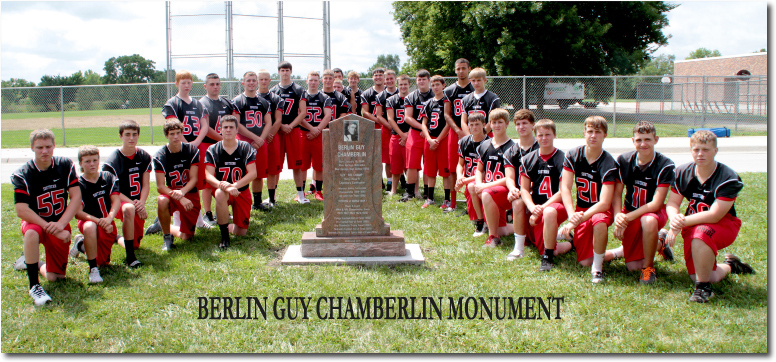Very few outstanding athletes in any sport become highly successful
head coaches or managers. One notable exception was Nebraska
native Guy Chamberlin, who was not only the state’s first
famous major college football star during the early years of
the 20th century but also professional football’s most successful
coach during the pioneering years of the National Football League.
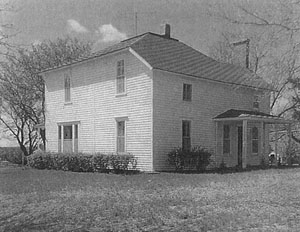
Guy Chamberlin birthplace (photo criteria 1940s)
His natural athletic capabilities were
enhanced with chores while growing up in Gage County on the family
farm northeast of Blue Springs, a town with a 1900 population
of 786 and located near the larger communities of Wymore and
Beatrice. Guy and his five siblings helped the parents maintain
nearly 1,000 acres of farmland in Blue Springs and Rockford Townships,
and attended Rural School District 67, known as Valley Center,
situated a half mile from the Big Blue River.
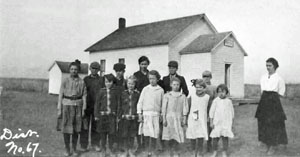
Schoot District 67 - 1915
An aunt was a District 67 teacher who
maintained strict discipline, reported Guy’s niece Dorothy
Chamberlin Savener in a May 23, 1996 interview. And she stated
that Guy’s father, who died in 1956 at the age of 95, was
“a small-built person, the patriarch of the family, a progressive
farmer ahead of his time, ambitious, a great believer in education
and hard work with no foolishness.” A story the patriarch
often told was that his own father shortened the name Chamberlain
to Chamberlin to get the name printed on a grain sack.
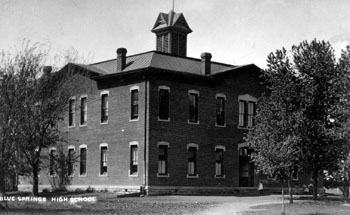
Blue Springs High School 1886-1919
To attend Blue Springs High School, which had an enrollment of
more than 50 students, Guy walked or sometimes traveled the 4
miles to school with a horse and buggy. School notes from 1908-10
in the Blue Springs Weekly Sentinel reveal there was a football
team, of which Guy was listed as captain, and in the spring,
baseball was played, though some members did not have uniforms.
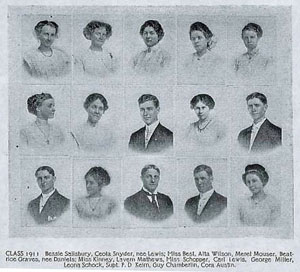
Blue Springs High School Class of 1911
In 1911, Guy was one of 14 graduates
from Blue Springs High School, and during his senior year the
superintendent was Franklin D. Keim, who shortly after became
an agronomy professor at the University of Nebraska-Lincoln,
where one of his students in the 1920s was George Beadle, later
a Nobel Prize-winning geneticist in 1958. It is also of interest
that the superintendent at Blue Springs during the 1912-13 school
year was Charles L. Littel, later known nationally for establishing
the first junior college in the state of Washington in 1925 and
the first coed junior college in New Jersey in 1933.
When Guy enrolled at Nebraska Wesleyan in the fall of 1911, his
father decided that he and his brothers, while spending their
college years in Lincoln, would reside in that city with their
mother Anna, then return to the farm during summer vacations.
This unusual parental effort also continued with his sibling
twins a few years later.
Nebraska Wesleyan was founded as a liberal arts college in 1887
by representatives of the United Methodist Church, and at present
remains affiliated with the Methodists, though chapel is no longer
required, and students of any faith are admitted. It began allowing
football on campus in 1893, though not as an organized program,
then outlawed the game in 1898 after complaints about the violence,
reported the college history by David H. Mickey titled Of Sunflowers,
Coyotes, and Plainsmen, Vol 1 (1992).
Nationwide, Eastern colleges had begun offering Rugby-style football
in the 1870s, according to The World Book Encyclopedia, Vol 7
(2005). The game evolved by 1900, but it consisted mainly of
running, blocking, and tackling, uniforms offered little protection,
and helmets were not used. Concerns about its safety were raised,
and after U.S. President Theodore Roosevelt in 1905 urged changes
be made in the game, numerous rules were adopted a year later
in officiating, crossing the scrimmage line, and penalties for
roughness. Also required was a gain of 10 yards, not 5, in three
downs, and the forward pass was introduced, though the latter
was not widely used until after 1913.
By this time, Nebraska Wesleyan had improved its athletic facilities,
had begun organized programs in basketball, baseball, and track,
and competed against teams in the Nebraska Intercollegiate Athletic
Association and elsewhere. In 1908, a football program was resumed.
Arriving along with Chamberlin in the fall of 1911 was new athletic
coach William G. Kline, who proceeded to develop championship
teams in virtually all sports. At this time, the touchdown was
still 5 points, and nearly everyone played the entire game on
both offense and defense.
As a freshman, Guy was about 6 feet 2 inches tall and weighed
180 pounds. Despite beginning the season with minor injuries,
he excelled as an end and a halfback for the Wesleyan team that
was undefeated in 7 games, outscored opponents 93 to 10, and
won the NIAA championship. Guy was one of the players chosen
for the state college All-Nebraska team by the Omaha World Herald.
The following spring, he was a baseball pitcher and outfielder,
batted .316 in nine games, and Wesleyan won all its games in
a championship season. He also competed on the championship track
team and was selected as its captain for the following year.
The May 31, 1912 Wesleyan noted Guy’s track prowess and
that “he is especially strong in the short distances and
weights.”
For the 1912 football season, rules changes included four downs,
not three, for a gain of 10 yards, the forward pass may be made
from anywhere for any distance, and a touchdown goes from 5 points
to 6 points. Wesleyan lost that fall to the University of South
Dakota and Colorado College, but won the rest.
Again Guy was among the players selected to the state team in
the December 1, 1912 World Herald, which further commented, “Chamberlin
is almost in a class by himself. He is a fierce and aggressive
runner and adopts the system of bowling over the opposing tacklers
in much the same style as the famous Coy of Yale. Chamberlin
rarely used a stiff arm, and yet many times it was next to impossible
to stop him.”
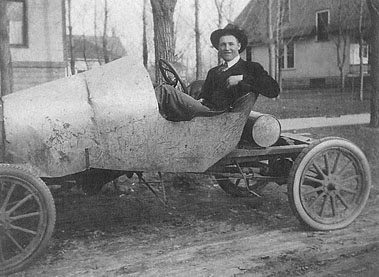
"Here is the Ford. Since I had this taken, I have built
a rear end. It will soon be painted and look very spiffy"
- Guy
Taken in Lincoln 1914-15 and sent to his Dad
Aside from sports, he also distinguished
himself by belonging to the Everett Literary Society, and in
March 1912 participated in a freshmen act during “College
Night” by giving greetings. Two months later, he was chosen
to serve in the cabinet of the Young Men’s Christian Association.
In the fall of 1913, Chamberlin transferred to the University
of Nebraska-Lincoln as a result of persuasion from various Cornhusker
emissaries, though the rules did not permit him to play on the
varsity that season. Football had been played at UNL since 1890,
its team began performing in 1909 at the newly constructed Nebraska
Field, which accommodated 8,000 spectators, and it hired its
first full-time head coach in 1911.
From 1911 to 1915, the era of coach Ewald O. Stiehm, the UNL
football teams compiled a record of 35 wins, two losses, and
three ties. Moreover, each of the five years, the Cornhuskers
won championships in the Missouri
Valley Conference, and gained national recognition during
1914 and 1915, the years Chamberlin was their star player.
The young coach Stiehm, a University of Wisconsin graduate, “tolerated
no nonsense, his instructions were carried out with punctuality
and precision. He wanted execution, he wanted his players to
be harder and tougher than anyone they played, and they played
the best, including Minnesota and Notre Dame,” according
to the James Denney, Hollis Limprecht, and Howard S. Silber history
Go Big Red (Kratville, 1966, 1971). He also started spring training
in 1913, the same year that some colleges nationally began placing
numbers on players’ uniforms.
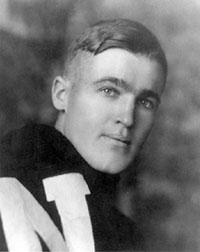
Chamberlin UNL 1914
In the fall of 1914, Guy weighed over
190 pounds, and endured some soreness in an ankle and knee various
times. He played right halfback, could toss a lefthanded forward
pass, and scored 9 touchdowns. On October 24, when the Cornhuskers
defeated Michigan State by a score of 24-0, he had run a kick-off
back 90 yards and scored a touchdown on a 2-yard run, and while
playing defensive end, he had broken through and spoiled many
plays. The next day, the World Herald quoted the Michigan coach
as saying, in part, “Nebraska has the making of one of the
greatest football teams in the entire country.”
That season, the team was undefeated except for one scoreless
tie, tackle and team captain Vic Halligan was named to Walter
Camp’s All-America third team, while Chamberlin, who was
mentioned by some national critics, was one of seven Nebraskans
placed on the All-Missouri Valley team.
In 1915,
his senior season, Chamberlin played left end, scored 15
touchdowns, and the team had an unbeaten record of 8 wins, no
losses, no ties. It was not until 1965, exactly 50 years later,
that the UNL football team enjoyed another unbeaten regular season,
that time with Robert S. Devaney as head coach. Guy played a
major role in the famous 20-19 defeat on October 23, 1915 of
national powerhouse Notre Dame, which at the time had as an assistant
coach Knute Rockne, who later became its legendary head coach
from 1918 to 1930.
The next day, in a World Herald article under the full-page headline
“It Was Two Much Chamberlin, Said Coach Harper,” he
was credited with scoring two touchdowns and passing for another.
And it was further stated, in part, “His defensive stunts
bordered upon the miraculous, while his open field running, in
which he displayed that famous ‘side walk trot’ to
the best advantage, brought victory to the colors of the Cornhuskers.”
Referee of the Notre Dame game was Walter Eckersall, a Chicago
Tribune sportswriter who selected Guy for his All-America team
at season’s end. Guy was also selected for an All-America
team by Frank G. Menke, sports editor for Hearst’s International
News Service, and he was placed on the All-Missouri Valley team.
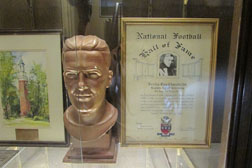
Chamberlin's NFL Hall of Fame Bust & Certificate
are displayed in the Gallery Cabinet at Beta Theta Pi
While a student at UNL, Chamberlin affiliated
with the social fraternity Beta Theta Pi, and played baseball
in the spring semester of his senior year in what was called
the Inter-Departmental League, since varsity baseball had been
discontinued after 1913, according to the 1916 Cornhusker, the
college annual. He pitched for the Academics team that won the
championship that spring. On June 7, 1916, he received his bachelor’s
degree with a major in political economy.
Guy then helped his father with farming for more than a year.
There were, however, various press reports that he might enter
the local banking business, that he was preparing to play professional
baseball for teams at Wichita or Indianapolis, and that he was
engaged in July 1916 to coach at Doane College in Crete that
fall.
During the 1917-18 school year, he was principal and coach of
athletics at Lexington High School, reported the October 12 and
December 14, 1917 Lexington Clipper-Citizen. The 1910 U.S. Census
reported the Dawson County town of Lexington had a population
of 2,059.
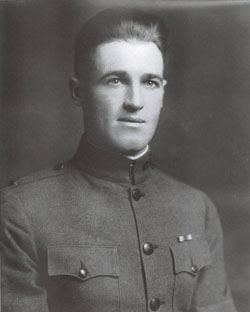
2nd Lieutenant Chamberlin
From May 1918 to October 1919, he was
in the U.S. Army, records with the Veteran’s Administration
reveal, and while achieving the rank of 2nd Lieutenant in the
Field Artillery, he was stationed at Camp Zachary Taylor, Kentucky,
then Fort Sill, Oklahoma, and finally Camp Kearny near San Diego,
California, reported Who’s Who in Nebraska (Nebraska Press
Association, 1940).
Guy was married at San Diego on January 3, 1919 to Lucile B.
Lees, who had previously graduated from UNL in August 1918. Her
father James T. Lees (1889-1926) was UNL professor of ancient
languages, and after he died, his cremated remains were placed
near the Schiller Linden tree north of Architectural Hall on
the City Campus, reported the May 25, 1955 Daily Nebraskan, the
UNL student newspaper.
Upon discharge from the Army in 1919, Guy began playing professional
football for the Canton, Ohio Bulldogs at the invitation of player-coach
Jim Thorpe, the Native American athlete who had won two gold
medals at the 1912 Olympics but preferred playing professional
football, even though it was not well organized. Thorpe had been
an idol of Chamberlin, who played the position of end during
Canton’s unofficial championship in 1919.
The following year, the professional sport became organized as
the American Professional Football Association, and was comprised
of 14 teams. In 1922, it was given its current name National
Football League, and membership had increased to at least 20
teams. Guy most certainly participated as a player or player/coach
from 1920 to 1926, then he retired and worked in Cleveland as
a salesman of farm implements in 1927, though there are some
accounts and records that erroneously report he was involved
with the Chicago Cardinals in 1927-28.
In 1920 and 1921, he played left end for the Staleys, which were
located the first year in Decatur, Illinois, then moved the next
year to Chicago, and eventually became renamed the Bears. Chamberlin
was discovered during a Midwest recruiting trip by head coach
George S. Halas, who was one of the major organizers of the first
professional circuit and at his death in 1983 had a professional
career as player, coach and owner for 64 years. At the time,
pro football players were dependent upon jobs outside the sport
for their main income, so Chamberlin worked part-time in the
A. E. Staley starch factory.
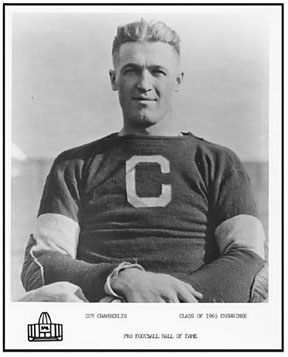
Pro Football Hall of Fame (1965)
According to a Pro Football Hall or
Fame biography, the two years Guy was with the Staleys resulted
in a disputed championship in 1920 and the first official title
in 1921, the latter occurring as a result of a crucial final
game with Buffalo. The legendary George Halas, in the first of
a three-part autobiographical article published in the November
23, 1957 Saturday Evening Post, recalled that “Chamberlin
was the best 2-way end I’ve ever seen. He was a tremendous
tackler on defense and a triple-threat performer on offense.
He was the star of the day against Buffalo, running 70 yards
with an intercepted pass to score our only touchdown in a 10-to-7
victory.”
In 1922, Chamberlin began his exceptional years in the dual role
of head coach and player by returning to Canton, where the Bulldogs
were National Football League champions with a record of 10 wins,
no losses, and two ties. In 1923, they were again champions with
a record of 11 wins, no losses, and one tie. The following year,
Guy and most of his players followed the relocation of the Bulldogs
to Cleveland, where they were 1924 champions with a record of
7 wins, one loss, and one tie.|
In George Sullivan, Pro Football’s All-Time Greats (G. P.
Putnam’s Sons, 1968), one of the Bulldog players was quoted
as saying, “Before Guy came to Cleveland, we just met on
Sunday afternoons, ate lunch, and then played the game. But he
made us work; he had us start practicing every day.” In
an article in the April 12, 1965 Canton /OH/ Repository, Chamberlin
credited his team members, calling William “Link” Lyman
and Wilbur “Fats” Henry “the two greatest tackles
ever to play the pros,” and further noted, “Lots of
fans said they were responsible for our success and they were
about right.” He went on to name the remainder of the starting
lineup, including himself as one end.
It is of interest that Lyman had played football at the University
of Nebraska-Lincoln in 1918, 1919, and 1921, was inducted into
the Pro Football Hall of Fame in 1964, and “is credited
with being the first defensive lineman to shift his position
frequently, sometimes moving inside to play between the offensive
guard and tackle, at other times moving out between the tackle
and end,” according to Ralph Hickok, Sports Champions (Houghton
Mifflin, 1995).
In 1925, with the Cleveland team disbanded due to lack of finances,
Chamberlin was hired to coach the Yellowjackets of Frankford,
a suburb of Philadelphia. That fall, his team compiled a praiseworthy
record of 13 wins and 7 losses, but finished in sixth place in
the 20-team NFL.
In 1926, the Frankford Yellowjackets were league champions with
a record of 14 wins, one loss, and one tie. In a deciding game
against the Chicago Bears, Guy also played end, and made a difference
in the Yellowjackets victory. In Pro Football’s All-Time
Greats, the author reported Guy “broke through to block
Paddy Driscoll’s try for an extra point following a Chicago
touchdown, and late in the game he blocked Driscoll’s attempt
at a field goal. Frankford scored in the dying minutes of the
contest, then added the extra point, to eke out a 7-6 win.”
Thus in five years as NFL head coach from 1922 to 1926, Chamberlin
won four championships, and had a total coaching record of 55
wins, 9 losses, and 5 ties—which ranks as the highest winning
percentage of any NFL coach with more than 50 victories. (Because
of allegations that Guy was with the Chicago Cardinals in 1927
and 1928, some accounts report different won/loss records.)
It was George Halas who also observed in the previously cited
November 23, 1957 autobiographical article, “Over five years
Chamberlin won four championships with 3 different teams, a coaching
record without parallel in National Football League history.”
It can also be stated that in the history of major North American
professional sports, the only other coach to have won league
championships with three different teams is Scotty Bowman, whose
nine Stanley Cups were with the NHL’s Pittsburgh Penguins,
Montreal Canadiens, and Detroit Red Wings. (A little known fact
is that Bowman coached the Omaha Knights for a brief time in
1963.)
In 1927, Guy ended his pro football career at the age of 32,
then worked as a salesman for organizations in Cleveland, where
he and Lucile divorced in a few years. In 1929, he applied—or
was considered—for the position of head football coach at
the University of Nebraska-Lincoln, reported his niece Dorothy
Savener. But D. X. Bible was hired, leaving Guy disappointed
for years.
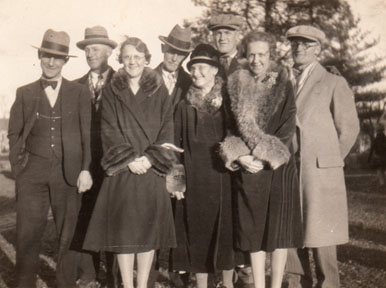
Front row: Frances, mother Anna, Ramona
Second Row: William, Warren, father Elmer, Guy,Truman
By 1932, he returned to Blue Springs
to manage his father’s large farm, and in the summers was
visited by his daughter Patricia. Though Guy attended Cornhusker
football games in Lincoln, he concentrated on his progressive
farming practices, including the use of a bulldozer and terracing
his father had initiated.
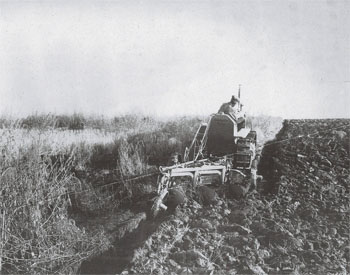
Guy shown plowing with a Caterpillar Tractor
"Our Caterpillar Diesel D2 Tractor replaces 16 head
of horses," report EE & B Guy Chamberlin of Gage County
In 1941, he and Bernyce Weekes of Beatrice
were married, and resided on the farm until June 1948 when they
relocated to Nebraska City, where Guy had bought a Ford-Ferguson
Agency. Meanwhile, his daughter Patricia, a 1945 UNL graduate,
was married at Brooklyn Heights, New York in 1947 to Beatrice
native Robert K. Sherwood, who worked for the U.S. Foreign Service.
The mother of two sons, Patricia Sherwood later died of cancer
in 1978 at the age of 55.
Guy sold the Nebraska City business after becoming ill, and in
1954-55 moved to Lincoln, where he was a guard/educator at the
State Reformatory until at least 1962, the year its athletic
field was named after him.
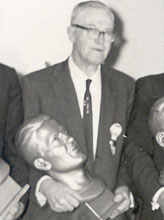
Pro Football Hall of Fame
Induction Ceremony NYC, 1965
Chamberlin’s major honors included
his 1962 election to the College Football Hall of Fame at South
Bend, Indiana and his 1965 induction into the Professional Hall
of Fame at Canton, Ohio. An annual Guy Chamberlin Trophy was
initiated in 1967 by the UNL Athletic Department to honor a senior
Cornhusker football player who exhibits the same qualities Guy
had while at UNL in 1914-15.
There is a display of Guy’s Pro Hall of Fame certificate
at the Beta Theta Pi house at 1515 R Street in Lincoln. And a
permanent exhibit on Chamberlin was established in 1997 at the
Gage County Historical
Society Museum in Beatrice.
Aside from the previously cited sources, other useful biographical
accounts include J. R. Johnson, Representative Nebraskans (Johnsen
Publishing, 1954) 41-44 and Biographical Dictionary of American
Sports: Football (Greenwood Press, 1987) 102-103 and Denis J.
Harrington, The Pro Football Hall of Fame (Greenwood Press, 1991)
80-81 and Beatrice Daily Sun, September 13, 1997, pp. A-1, A-2,
B-1 and American National Biography, Vol 4 (Oxford University
Press, 1999) 638.
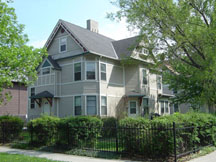
Last residence 1109 F St in Lincoln
Born Berlin Guy Chamberlin in 1894 near Blue Springs, Gage County,
one of six children of Elmer E. and Anna Tobyne Chamberlin, he
died in Lincoln on April 4, 1967 at the age of 73. Among the
survivors were his first wife Lucile, his second wife Bernyce,
daughter Patricia Sherwood, two grandsons, and several nieces,
nephews, and cousins.
For decades, Guy was called “The Champ” by the state’s
football enthusiasts, and the next day his obituary with a large
headline was published in the Lincoln Star sports section. His
cremated remains were placed by daughter Patricia on a prominent
hill in pastureland previously owned by the family in the southeast
quarter of Section 10 in Blue Springs Township. Present at the
burial ceremony were University of Nebraska representatives and
several relatives.
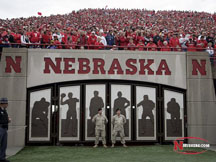
Memorial Stadium
Chamberlin silhouette right center
Nationally Distinguished Nebraskans – Guy Chamberlin: Farmer,
notable athlete, and coach of four pro football championships
with three different teams
Copyright (C) 2008 by E. A. Kral
Originally published in The Crete News, Dec. 3, 2008.
Used with permission
